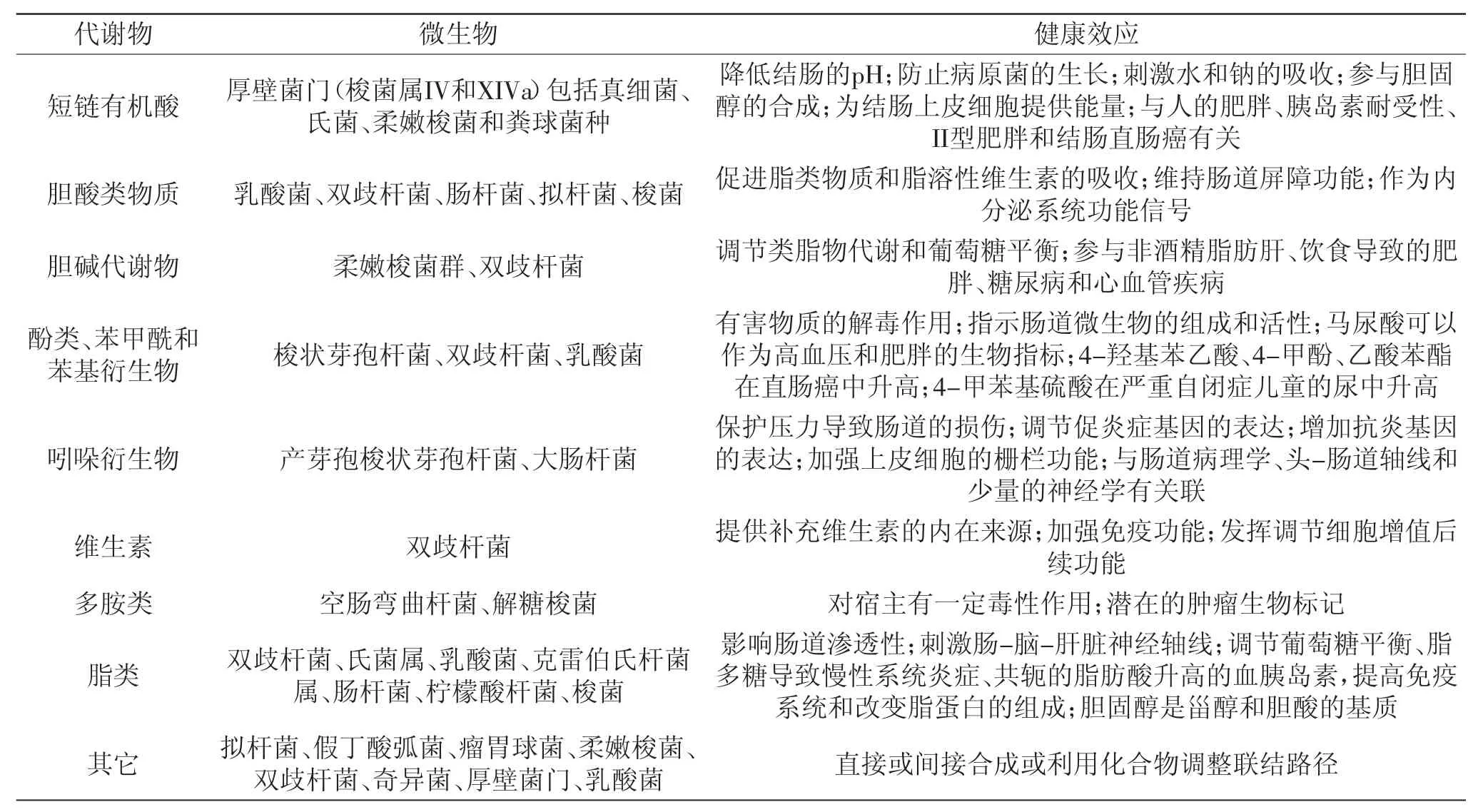婴幼儿肠道微生物的定植特征
范文广,王婷婷,霍贵成,*
(1.乳品科学教育部重点实验室,东北农业大学,黑龙江哈尔滨150030;2.黑龙江职业学院,黑龙江哈尔滨150111)
婴幼儿肠道微生物的定植特征
范文广1,2,王婷婷1,霍贵成1,*
(1.乳品科学教育部重点实验室,东北农业大学,黑龙江哈尔滨150030;2.黑龙江职业学院,黑龙江哈尔滨150111)
肠道微生物对人体的健康至关重要。婴儿肠道微生物的丰度、多样性以及构成变化较大,这些变化受母体、分娩、喂养、医疗、环境等因素影响。因此,婴幼儿肠道菌群的定植和变化标准是很难定义的。本文对早期婴幼儿肠道菌群定植与发展、微生物代谢产物的最新研究进展进行了论述。
婴幼儿,肠道微生物,定植,微生物代谢产物
人类体内大约有1014个细菌,超过人类基因数量的100倍[1-2]。最大微生物群落位于消化道的大肠中,它是宿主重要的组成部分,与宿主健康紧密相连。在过去10年中,受益于分子生物学技术的发展,婴幼儿肠道菌群研究已经取得了巨大进步[3-4]。定量PCR可以测定婴儿肠道内一些重要细菌,如双歧杆菌、肠杆菌、厚壁菌和拟杆菌;第二代代测序技术已经得到一个更完整的细菌系统发育图[5]。然而,一些技术因素(如PCR引物的选择或DNA的提取方法)极大地影响了这些研究[6]。研究婴幼儿肠道菌群定植可能影响与肠道微生物相关疾病的治疗,所以迫切需要澄清肠道菌群发展变化的规律及其功能。本文对婴幼儿肠道微生物定植、影响因素、微生物代谢产物的最新研究进行了论述,总结了婴幼儿肠道微生物定植的特征,为进一步研究婴幼儿肠道微生物提供一定的理论依据。
1 婴幼儿肠道微生物的定植
大多数研究者认为,健康成年人肠道菌群十分稳定,只是在特定人群中,可能会存在轻微变化[7-8]。婴幼儿与成年人的肠道微生物组成迥然不同,1岁左右时,婴幼儿肠道微生物组成与成年人具有一定相似性,并逐渐向成年人靠拢[9]。早期婴儿肠道定植的典型微生物包含兼性厌氧菌,如大肠杆菌和其他肠杆菌[10],这些微生物逐渐消耗肠道内的氧气,促进厌氧菌(如双歧杆菌、梭状芽孢杆菌、拟杆菌、瘤胃球菌)的生长。婴儿肠道微生物大约第3年的时候达到成人的状态。早期研究认为双歧杆菌是成人肠道典型的细菌[11],但最近的研究发现了这种细菌在婴幼儿肠道中的高丰度性[12-13],研究还发现双歧杆菌是婴幼儿肠道微生物中一个主要细菌[14-15],而且从15个婴幼儿粪便中鉴别出了6种不同双歧杆菌的菌种[16]。
婴幼儿肠道微生物定植与发展呈现连续的动态变化[17]。婴儿出生第一个月,肠道细菌组成变化十分复杂且频繁,包括一些短暂存在的细菌,一旦肠道环境发生改变这些细菌就会消失,但也有些细菌在成年时仍会存在,演变为固有细菌。从婴儿出生第1个月到第3年,肠道微生物多样性增加,拟杆菌门逐渐增加,随着婴儿断奶和饮食结构的变化,微生物利用碳水化合物的程度增加,生成了各种代谢产物,如短链有机酸、酚类、维生素等,以满足微生物自身和宿主的营养需要。随着时间的推移,婴幼儿肠道微生物组成逐渐达到成年人的状态。
2 影响婴幼儿肠道微生物定植的因素
虽然肠道微生物正常定植的时间和微生物类群已经十分明确,但是影响它们的各种因素很难完全确定,主要包括母体的影响、婴儿的分娩方式、婴儿喂养的方式、生活环境、抗生素的使用以及益生元或益生菌的添加,它们通过不同的形式影响婴幼儿肠道微生物的定植和发展。
2.1 母体的影响
普遍认为胎儿是无菌的,但是一些研究表明母体子宫内仍有细菌存在,母鼠口服补充大肠杆菌后,在其羊水检测到大肠杆菌[18]。这些细菌(如大肠杆菌、粪肠球菌和葡萄球菌)通过母体迁移给新生儿[10],它们可能会影响分娩前胎儿细菌的定植[18-22]。
孕期外部因素(药物、疾病、压力或重金属辐射等)也可能通过母体影响婴幼儿肠道微生物的定植和发展。研究表明怀孕后期的母亲服用益生菌(鼠李糖乳杆菌),分娩婴儿体内双歧杆菌数量增加[23]。动物研究表明,怀孕期间有外界压力的母猴分娩的婴猴,体内双歧杆菌和乳酸菌数量较少[24]。未来,需要更多研究去确定这些因素如何影响婴儿肠道微生物定植。
在婴儿的分娩、护理和早期喂养过程中,母体都和婴幼儿亲密接触,她可能是婴儿出生后影响肠道微生物定植最大的外部因素。研究发现,婴儿出生第一个月,肠道微生物在功能上和组成上都与母体微生物接近;婴儿出生后第六个月时,通过qPCR分析粪便微生物,发现母亲和婴儿中的微生物存在紧密关系,双歧杆菌、短双歧杆菌及金黄色葡萄球菌的存在是相互对应的[25];在十一个月时,开始出现明显差异[26]。
2.2 分娩方式
分娩方式(顺产或剖腹产)对早期婴幼儿肠道微生物定植有很大影响,特别是双歧杆菌的数量[27-28]。通过焦磷酸测序分析早产儿胎便,发现婴儿消化道微生物群落和母亲阴道(剖腹产)或皮肤的细菌(顺产)存在联系[29]。此外,TTGE和DGGE分析出生三天时婴儿粪便,显示顺产和剖腹产的婴儿肠道微生物存在不同,剖腹产婴儿双歧杆菌的数量较少,而顺产婴儿总微生物多样性较小[30]。
2.3 喂养方式
喂养方式对婴幼儿肠道微生物定植影响巨大。母乳喂养与人工喂养婴儿肠道菌群构成存在明显差异,母乳喂养的婴儿体内含有较多的双歧杆菌和乳酸菌,同时存在少量的拟杆菌、拟球梭菌、葡萄球菌和肠杆菌[31-34]。研究分析母体和母乳喂养婴幼儿粪便样品中细菌菌种的基因类型,发现存在相同菌株,这意味着婴幼儿早期微生物可能来自于母乳[35]。造成母乳与人工喂养婴儿肠道菌群差异的原因主要是由于母乳中的特殊营养,母乳中含有生长因子,能促进双歧杆菌、乳酸杆菌的生长;这些菌发酵产酸,使肠道pH降低,抑制其他需氧菌和兼性厌氧菌的生长;乳铁蛋白和免疫因子对大肠杆菌和致病菌有抑制作用[36]。婴幼儿奶粉的使用,迅速增加了拟杆菌的数量,也增加了与碳水化合物降解以及维生素合成有关功能性基因的丰度[16]。现在婴儿奶粉的开发,正在向更接近母乳的奶粉(如低敏性和结构性油脂奶粉)迈进[37]。
2.4 生活环境
婴儿出生后的生活环境也会影响婴儿肠道菌群的构成。不同国家、不同区域的婴儿肠道菌群结构有所不同,比较三种不同环境下0~3岁儿童粪便微生物时,发现微生物组成存在明显差异[5]。另外一个研究中,芬兰和德国儿童的肠道微生物也存在明显差异,芬兰婴儿比德国婴儿拥有更多数量的双歧杆菌[38]。家庭组成也能影响新生儿的肠道菌群,有哥哥或姐姐的婴儿粪便中细菌总数较低,但是双歧杆菌的丰度相对较高[20]。婴儿出生第一年,家庭环境的微生物开始在婴儿肠道中定植。肠道微生物或微生物相关性疾病(结肠炎、炎症性肠炎)能否从家庭成员传给婴幼儿还有待研究。
2.5 抗生素的使用
与母体、分娩方式、喂养方式的紧密联系以及与其他婴儿的接触,对所有的婴幼儿来说都是共同的。然而对于有些婴幼儿来说抗生素的使用是特殊的,这主要发生在疾病治疗过程中。大多数以药物为基础的治疗在某些程度上都会影响病人的微生物[39]。抗生素可用于肠道感染性疾病的治疗,但过量使用会改变肠道菌群,杀死肠道中有益微生物菌群,导致菌群失衡。研究发现,抗生素治疗的婴儿有较高比例的肠道菌和肠球菌以及较低比例的双歧杆菌[40]。出生时体重偏低的婴儿在早期抗生素治疗时,粪便细菌的多样性[12]和细菌总数明显减少[41]。母体的抗生素治疗(产前或喂养期间)与婴儿肠道中较少比例的拟杆菌属、奇异菌属以及细菌总数有一定联系[33]。可见,抗生素对婴儿肠道菌群的定植会产生影响,尽量减少抗生素的使用,有利于婴儿肠道菌群的定植和发展。
2.6 益生菌和益生元的添加
不同微生物的连续性对婴幼儿肠道成熟至关重要。在这些微生物中,双歧杆菌和其他的乳酸菌被看作是必需和有益的,它们具有益生特性。在成人体内,它们以短暂的方式在肠道定植,停止摄取两周后,粪便样品中很难被检测到[42]。母体在分勉前和母乳喂养过程中补充益生菌,影响了婴儿肠道双歧杆属细菌的定植,增加了双歧杆菌的多样性[43]。与对照组比较,喂养富含双歧杆菌婴儿奶粉的早产儿肠道中,双歧杆菌数量较高[44]。在婴儿出生时,喂养添加益生元(低聚半乳糖和长链的低聚果糖)的婴儿配方奶粉,减少了梭状芽孢杆菌和大肠杆菌的数量,同时轻微增加了双歧杆菌的数量[45]。益生菌和益生元能起到防止婴儿腹泻[46]、坏死性小肠结肠炎[47]、湿疹[48]及过敏性皮炎[49]等益生作用,还可能起到降胆固醇作用[50]。
3 肠道微生物的代谢产物
肠道微生物能通过其产生的代谢产物发挥有益作用,宿主和它们的肠道微生物在食物和外源性物质代谢过程中产生大量小分子物质,和身体内所谓“智能通讯”系统紧密联系,这些系统包括免疫、内分泌等[21]。调节宿主-微生物之间相互作用的代谢产物主要分类和健康效应见表1,但有可能存在更多代谢产物。

表1 部分微生物的代谢产物以及机体的健康效应Table.1 Part microbial metabolites and the health effect for the host
4 结论及展望
综上所述,婴幼儿肠道微生物定植的特征为:a.婴儿出生后不久,来自母体和环境中的微生物开始定植于婴幼儿肠道;b.婴幼儿肠道内细菌定植,最早是兼性厌氧菌,几天或几周后,厌氧菌变得十分丰富,主要以双歧杆菌为主;c.微生物发展和最终定植受早期定植微生物的影响;d.细菌定植依赖于婴儿的饮食;e.早期微生物定植影响婴儿健康和疾病,相反地,微生物干预(抗生素、益生菌和益生元)影响婴幼儿早期和后来出现疾病的风险;f.婴幼儿早期肠道微生物通过其代谢产物发挥作用。
近年来,婴幼儿肠道微生物发展的动态变化和不同因素对它的影响已经取得了巨大的进步,发现婴幼儿早期肠道微生物变化规律与肠道代谢及相关性疾病有一定相关性,我们应该有深度地去研究早期微生物变化和成年疾病(如过敏或肥胖)之间的关系,有针对性地调整婴幼儿肠道微生物,发展新的治疗方法来减少婴幼儿患病的风险。
[1]Qin J,Li R,Raes J,et al.A human gut microbial gene catalogue established by metagenomic sequencing[J].Nature,2010,464(7285):59-65.
[2]Ley RE,Peterson DA,Gordon JI,et al.Ecological and evolutionary forces shaping microbial diversity in the human intestine[J].Cell,2006,124(4):837-848.
[3]Turnbaugh PJ,Ley RE,Hamady M,et al.The human microbiome project[J].Nature,2007,449:804-810.
[4]Arumugam M,Raes J,Pelletier E,et al.Enterotypes of the human gut microbiome[J].Nature,2011,473:174-180.
[5]Yatsunenko T,Rey FE,Manary MJ,et al.Human gut microbiome viewed across age and geography[J].Nature,2012,486:222-227.
[6]Ventura M,Turroni F,Canchaya C,et al.Microbial diversity in the human intestine and novel insights from metagenomics[J]. Frontiers in Bioscience:A Journal and Virtual Library,2009(14):3214-3221.
[7]Vanhoutte T,Huys G,Brandt E,et al.Temporal stability analysis of the microbiota in human feces by denaturing gradient gel electrophoresis using universal and group-specific 16S rRNA gene primers[J].FEMS Microbiology Ecology,2004,48(3):437-446.
[8]De La Cochetière MF,Durand T,Lepage P,et al.Resilience of the dominant human fecal microbiota upon short-course antibiotic challenge[J].Journal of Clinical Microbiology,2005,43(11):5588-5592.
[9]Palmer C,Bik EM,DiGiulio DB,et al.Development of the human infant intestinal microbiota[J].PLoS Biology,2007,5(7):e177.
[10]Jiménez E,Marín ML,Martín R,et al.Is meconium from healthy newborns actually sterile?[J].Research in Microbiology,2008,159(3):187-193.
[11]Ventura M,O’Flaherty S,Claesson MJ,et al.Genome-scale analyses of health-promoting bacteria:probiogenomics[J].Nature reviews-Microbiology,2009,7(1):61-71.
[12]Arboleya S,Binetti A,Salazar N,et al.Establishment and development of intestinal microbiota in preterm neonates[J]. FEMS Microbiology Ecology,2012,79(3):763-772.
[13]Koenig JE,Spor A,Scalfone N,et al.Succession of microbial consortia in the developing infant gut microbiome[J].Proceedings of the National Academy of Sciences of the United States of America,2011,108(Suppl.1):4578-4585.
[14]Harmsen HJ,Wildeboer-Veloo AC,Raangs GC,et al.Analysis of intestinal flora development in breast-fed and formula-fed infants by using molecular identification and detection methods [J].Journal of Pediatric Gastroenterology and Nutrition,2000,30(1):61-67.
[15]Turroni F,Peano C,Pass DA,et al.Diversity of Bifidobacteria within the infant gut microbiota[J].PLoS ONE,2012,7(5):e36957.
[16]Aires J,Thouverez M,Allano S,et al.Longitudinal analysis and genotyping of infant dominant bifidobacterial populations[J]. Systematic and Applied Microbiology,2011,34(7):536-541.
[17]Clemente JC,Ursell LK,Parfrey LW,et al.The Impact of the Gut Microbiota on Human Health:An Integrative View[J]. Cell,2012,148(6):1258-1270.
[18]Jiménez E,Fernández L,Marín ML,et al.Isolation of commensal bacteria from umbilical cord blood of healthy neonates born by cesarean section[J].Current Microbiology,2005,51(4):270-274.
[19]DiGiulio DB,Romero R,Amogan HP,et al.Microbial prevalence,diversity and abundance in amniotic fluid during preterm labor:a molecular and culture-based investigation[J]. PLoS One,2008,3(8):e3056.
[20]Penders J,Thijs C,Vink C,et al.Factors influencing the composition of the intestinal microbiota in early infancy[J]. Pediatrics,2006,118(2):511-521.
[21]Mackie RI,Sghir A,Gaskins HR.Developmental microbial ecology of the neonatal gastrointestinal tract[J].The American Journal of Clinical Nutrition,1999,69(5):S1035-S1045.
[22]Madan JC,Salari RC,Saxena D,et al.Gut microbial colonisation in premature neonates predicts neonatal sepsis[J]. Archives of Disease in Childhood:Fetal and Neonatal Edition,2012,97(6):F456-F462.
[23]Lahtinen SJ,Boyle RJ,Kivivuori S,et al.Prenatal probiotic administration can influence Bifidobacterium microbiota development in infants at high risk of allergy[J].The Journal of Allergy and Clinical Immunology,2009,123(2):499-501.
[24]Bailey MT,Lubach GR,Coe CL.Prenatal stress alters bacterial colonization of the gut in infant monkeys[J].Journal of Pediatric Gastroenterology and Nutrition,2004,38(4):414-421.
[25]Grönlund MM,Grzes'kowiak Ł,Isolauri E,et al.Influence of mother’s intestinal microbiota on gut colonization in the infant [J].Gut Microbes,2011,2(4):227-233.
[26]Vaishampayan PA,Kuehl JV,Froula JL,et al.Comparative metagenomics and population dynamics of the gut microbiota in mother and infant[J].Genome Biology and Evolution,2012,2:53-66.
[27]Biasucci G,Rubini M,Riboni S,et al.Mode of delivery affects the bacterial community in the newborn gut[J].Early Human Development,2010,86(Suppl.1):13-15.
[28]张红波.陆薇,黄娟,等.不同分娩方式对母乳喂养婴儿肠道菌群的影响[J].临床儿科杂志,2010,28(3):251-254.
[29]Dominguez-Bello MG,Costello EK,Contreras M,et al. Delivery mode shapes the acquisition and structure of the initial microbiota acrossmultiple body habitatsin newborns[J]. Proceedings of the National Academy of Sciences of the United States of America,2010,107(26):11971-11975.
[30]Biasucci G,Benenati B,Morelli L,et al.Cesarean delivery may affect the early biodiversity of intestinal bacteria[J].The Journal of Nutrition,2008,138(9):S1796-S1800.
[31]Sahl JW,Matalka MN,Rasko DA.Phylomark:a tool to identify conserved phylogenetic markers from whole-genome alignments [J].Applied and EnvironmentalMicrobiology,2012,78(14):4884-4892.
[32]Fernández L,Langa S,Martín V,et al.The human milk microbiota:origin and potential roles in health and disease[J]. Pharmacological Research,2013,69(1):1-10.
[33]Fallani M,Young D,Scott J,et al.Intestinal microbiota of 6-week-old infants across Europe:geographic influence beyond delivery mode,breastfeeding,and antibiotics[J].Journal of Pediatric Gastroenterology and Nutrition,2010,51(1):77-84.
[34]李晓敏,杨丽杰,霍贵成.Illumina技术研究不同喂养方式婴儿肠道菌群差异[J].食品科技,2012,37(9):319-324.
[35]Martín V,Maldonado-Barragán A,Moles L,et al.Sharing of bacterial strains between breast milk and infant feces[J].The Journal of Human Lactation,2012,28(1):36-44.
[36]Petschow BW,Talbott RD,BatemaA RP.Ability of lactoferrin to promote the growth of Bifidobacterium spp.in vitro is independent of receptor binding capacity and iron saturation level[J].J Med Microbiol,1999,48:541-549.
[37]洪滨,赵亚东,霍贵成.仿早产儿母乳脂肪配方奶粉及其消化率的评价[J].食品科技,2011,36(9):106-112.
[38]Grzes'kowiak Ł,Grönlund MM,Beckmann C,et al.The impact of perinatal probiotic intervention on gut microbiota:double-blind placebo-controlled trials in Finland and Germany [J].Anaerobe,2012,18(1):7-13.
[39]Dethlefsen L,Huse S,Sogin ML,et al.The pervasive effects of an antibiotic on the human gut microbiota,as revealed by deep 16S rRNA sequencing[J].PLoS Biology,2011,6(11):e280.
[40]Tanaka S,Kobayashi T,Songjinda P,et al.Influence of antibiotic exposure in the early postnatalperiod on the development of intestinal microbiota[J].FEMS Immunology and Medical Microbiology,2009,56(1):80-87.
[41]Westerbeek EA,Berg AV,Lafeber,HN,et al.The intestinal bacterial colonization in preterm infants:a review of the literature [J].Clinical Nutrition,2006,25:361-368.
[42]Sanders ME,Akkermans LM,Haller D,et al.Safety assessment of probiotics for human use[J].Gut Microbes,2010,1(3):164-185.
[43]Gueimonde M,Sakata S,Kalliomäki M,et al.Effect of maternal consumption of Lactobacillus GG on transfer and establishment of fecal bifidobacterial microbiota in neonates[J].Journal of Pediatric Gastroenterology and Nutrition,2006,42(2):166-170.
[44]Underwood MA,Salzman NH,Bennett SH,et al.A randomized placebo-controlled comparison of 2 prebiotic/probiotic combinations in preterm infants:impact on weight gain,intestinal microbiota,and fecal short-chain fatty acids[J].Journal of Pediatric Gastroenterology and Nutrition,2009,48(2):216-225.
[45]Costalos C,Kapiki A,Apostolou M,et al.The effect of a prebiotic supplemented formula on growth and stool microbiology of term infants[J].Early Human Development,2008,84(1):45-49.
[46]Sazawal S,Hiremath G,Dhingra U,et al.Efficacy of probiotics in prevention of acute diarrhoea:a meta-analysis of masked, randomised,placebo-controlled trials[J].The Lancet Infectious Diseases,2006,6(6):374-382.
[47]Lin HC,Hsu CH,Chen HL,et al.Oral probiotics prevent necrotizing enterocolitis in very low birth weight preterm infants:a multicenter,randomized,controlled trial[J].Pediatrics,2008,122(4):693-700.
[48]Rautava S,Kainonen E,Salminen S,et al.Maternal probiotic supplementation during pregnancy and breast-feeding reduces the risk of eczema in the infant[J].The Journal of Allergy and Clinical Immunology,2012,130(6):1355-1360.
[49]Lee J,Seto D,Bielory L.Meta-analysis of clinical trials of probiotics for prevention and treatment of pediatric atopic dermatitis[J].The Journal of Allergy and Clinical Immunology,2008,121(1):116-121.
[50]国立东,杨丽杰,霍贵成.乳酸菌降胆固醇机制的研究进展[J].食品与发酵工业,2013,39(2):117-122.
Feature of intestinal microbial colonization in infants
FAN Wen-guang1,2,WANG Ting-ting1,HUO Gui-cheng1,*
(1.Key Lab of Dairy Science,Ministry of Education,Northeast Agricultural University,Harbin 150030,China;2.Hei LongJiang Vocational College,Harbin 150111,China)
The gastrointestinal microbiota plays a crucial role in human health.Development of the intestinal microbiota in infants is characterized by large changes in microbial abundance,diversity,and composition. These changes are influenced by maternal,feeding,delivery,medical and environmental factors.Thus,it is nearly impossible to define a universal standard for intestinal colonization and development of the intestinal microbiota.Recent data on the early colonization and development of the intestinal microbiota,microbial metabolites were discussed in this review.
infant;intestinal microbiota;colonization;microbial metabolites
TS201
A
1002-0306(2014)06-0383-05
2013-07-17 *通讯联系人
范文广(1982-),男,博士,研究方向:食品科学。
“乳酸菌代谢调控与发酵剂制造技术”教育部长江学者和创新团队发展计划(IRT0959)。

